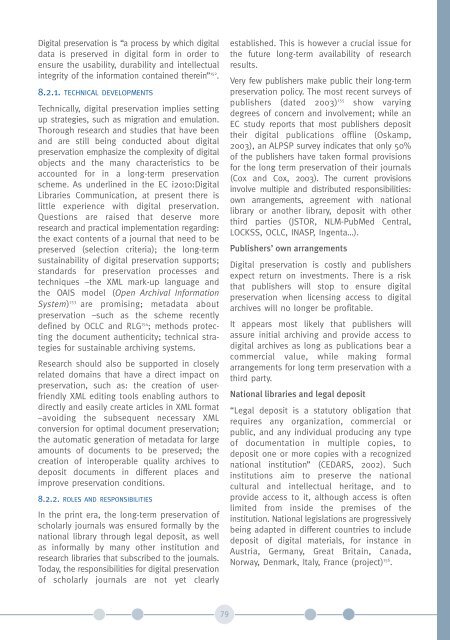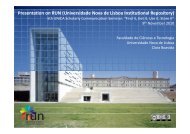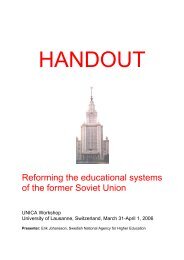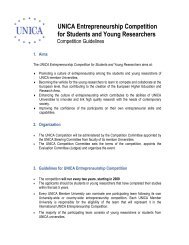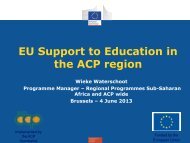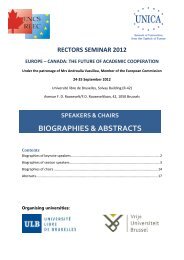Study on the economic and technical evolution of the scientific ...
Study on the economic and technical evolution of the scientific ...
Study on the economic and technical evolution of the scientific ...
You also want an ePaper? Increase the reach of your titles
YUMPU automatically turns print PDFs into web optimized ePapers that Google loves.
Digital preservati<strong>on</strong> is “a process by which digital<br />
data is preserved in digital form in order to<br />
ensure <strong>the</strong> usability, durability <strong>and</strong> intellectual<br />
integrity <strong>of</strong> <strong>the</strong> informati<strong>on</strong> c<strong>on</strong>tained <strong>the</strong>rein” 152 .<br />
8.2.1. TECHNICAL DEVELOPMENTS<br />
Technically, digital preservati<strong>on</strong> implies setting<br />
up strategies, such as migrati<strong>on</strong> <strong>and</strong> emulati<strong>on</strong>.<br />
Thorough research <strong>and</strong> studies that have been<br />
<strong>and</strong> are still being c<strong>on</strong>ducted about digital<br />
preservati<strong>on</strong> emphasize <strong>the</strong> complexity <strong>of</strong> digital<br />
objects <strong>and</strong> <strong>the</strong> many characteristics to be<br />
accounted for in a l<strong>on</strong>g-term preservati<strong>on</strong><br />
scheme. As underlined in <strong>the</strong> EC i2010:Digital<br />
Libraries Communicati<strong>on</strong>, at present <strong>the</strong>re is<br />
little experience with digital preservati<strong>on</strong>.<br />
Questi<strong>on</strong>s are raised that deserve more<br />
research <strong>and</strong> practical implementati<strong>on</strong> regarding:<br />
<strong>the</strong> exact c<strong>on</strong>tents <strong>of</strong> a journal that need to be<br />
preserved (selecti<strong>on</strong> criteria); <strong>the</strong> l<strong>on</strong>g-term<br />
sustainability <strong>of</strong> digital preservati<strong>on</strong> supports;<br />
st<strong>and</strong>ards for preservati<strong>on</strong> processes <strong>and</strong><br />
techniques –<strong>the</strong> XML mark-up language <strong>and</strong><br />
<strong>the</strong> OAIS model (Open Archival Informati<strong>on</strong><br />
System) 153 are promising; metadata about<br />
preservati<strong>on</strong> –such as <strong>the</strong> scheme recently<br />
defined by OCLC <strong>and</strong> RLG 154 ; methods protecting<br />
<strong>the</strong> document au<strong>the</strong>nticity; <strong>technical</strong> strategies<br />
for sustainable archiving systems.<br />
Research should also be supported in closely<br />
related domains that have a direct impact <strong>on</strong><br />
preservati<strong>on</strong>, such as: <strong>the</strong> creati<strong>on</strong> <strong>of</strong> userfriendly<br />
XML editing tools enabling authors to<br />
directly <strong>and</strong> easily create articles in XML format<br />
–avoiding <strong>the</strong> subsequent necessary XML<br />
c<strong>on</strong>versi<strong>on</strong> for optimal document preservati<strong>on</strong>;<br />
<strong>the</strong> automatic generati<strong>on</strong> <strong>of</strong> metadata for large<br />
amounts <strong>of</strong> documents to be preserved; <strong>the</strong><br />
creati<strong>on</strong> <strong>of</strong> interoperable quality archives to<br />
deposit documents in different places <strong>and</strong><br />
improve preservati<strong>on</strong> c<strong>on</strong>diti<strong>on</strong>s.<br />
8.2.2. ROLES AND RESPONSIBILITIES<br />
In <strong>the</strong> print era, <strong>the</strong> l<strong>on</strong>g-term preservati<strong>on</strong> <strong>of</strong><br />
scholarly journals was ensured formally by <strong>the</strong><br />
nati<strong>on</strong>al library through legal deposit, as well<br />
as informally by many o<strong>the</strong>r instituti<strong>on</strong> <strong>and</strong><br />
research libraries that subscribed to <strong>the</strong> journals.<br />
Today, <strong>the</strong> resp<strong>on</strong>sibilities for digital preservati<strong>on</strong><br />
<strong>of</strong> scholarly journals are not yet clearly<br />
established. This is however a crucial issue for<br />
<strong>the</strong> future l<strong>on</strong>g-term availability <strong>of</strong> research<br />
results.<br />
Very few publishers make public <strong>the</strong>ir l<strong>on</strong>g-term<br />
preservati<strong>on</strong> policy. The most recent surveys <strong>of</strong><br />
publishers (dated 2003) 155 show varying<br />
degrees <strong>of</strong> c<strong>on</strong>cern <strong>and</strong> involvement; while an<br />
EC study reports that most publishers deposit<br />
<strong>the</strong>ir digital publicati<strong>on</strong>s <strong>of</strong>fline (Oskamp,<br />
2003), an ALPSP survey indicates that <strong>on</strong>ly 50%<br />
<strong>of</strong> <strong>the</strong> publishers have taken formal provisi<strong>on</strong>s<br />
for <strong>the</strong> l<strong>on</strong>g term preservati<strong>on</strong> <strong>of</strong> <strong>the</strong>ir journals<br />
(Cox <strong>and</strong> Cox, 2003). The current provisi<strong>on</strong>s<br />
involve multiple <strong>and</strong> distributed resp<strong>on</strong>sibilities:<br />
own arrangements, agreement with nati<strong>on</strong>al<br />
library or ano<strong>the</strong>r library, deposit with o<strong>the</strong>r<br />
third parties (JSTOR, NLM-PubMed Central,<br />
LOCKSS, OCLC, INASP, Ingenta…).<br />
Publishers’ own arrangements<br />
Digital preservati<strong>on</strong> is costly <strong>and</strong> publishers<br />
expect return <strong>on</strong> investments. There is a risk<br />
that publishers will stop to ensure digital<br />
preservati<strong>on</strong> when licensing access to digital<br />
archives will no l<strong>on</strong>ger be pr<strong>of</strong>itable.<br />
It appears most likely that publishers will<br />
assure initial archiving <strong>and</strong> provide access to<br />
digital archives as l<strong>on</strong>g as publicati<strong>on</strong>s bear a<br />
commercial value, while making formal<br />
arrangements for l<strong>on</strong>g term preservati<strong>on</strong> with a<br />
third party.<br />
Nati<strong>on</strong>al libraries <strong>and</strong> legal deposit<br />
“Legal deposit is a statutory obligati<strong>on</strong> that<br />
requires any organizati<strong>on</strong>, commercial or<br />
public, <strong>and</strong> any individual producing any type<br />
<strong>of</strong> documentati<strong>on</strong> in multiple copies, to<br />
deposit <strong>on</strong>e or more copies with a recognized<br />
nati<strong>on</strong>al instituti<strong>on</strong>” (CEDARS, 2002). Such<br />
instituti<strong>on</strong>s aim to preserve <strong>the</strong> nati<strong>on</strong>al<br />
cultural <strong>and</strong> intellectual heritage, <strong>and</strong> to<br />
provide access to it, although access is <strong>of</strong>ten<br />
limited from inside <strong>the</strong> premises <strong>of</strong> <strong>the</strong><br />
instituti<strong>on</strong>. Nati<strong>on</strong>al legislati<strong>on</strong>s are progressively<br />
being adapted in different countries to include<br />
deposit <strong>of</strong> digital materials, for instance in<br />
Austria, Germany, Great Britain, Canada,<br />
Norway, Denmark, Italy, France (project) 156 .<br />
79


